Introduction to Chinese Seals
|
清.王撰《寶晉齋印譜》 Chinese seal carving is not an average skill. It is indispensable to deal with the methodologies of (seal script) calligraphy, ideas, and carving. The ancient Chinese wrote according to the Six Principles to compose Chinese scripts; a minimal error or deviation results in wide divergence. If one creates new scripts without studying and obeying the principles, the writing is not considered calligraphy. As for designing the arrangement of scripts in a seal, one has to consider the disposition of strokes and the various effects. The designs are different for seals with one or several characters - their angles, roundness, and lengths differ. There always exist principles as to modify the angles, roundness and lengths. If there is a minimal incoherence, it is not a good design. As for carving, do not imitate the shapes of a sparrow's tail or a saw's teeth. Practicing diligently for many days and months will help the carver obtain proficiency, natural smoothness and coherence, and joyfulness. On the contrary, if one labors to copycat ancient seals without understanding, traces of incoherence will show and this is not considered good carving. Adapted from Seal Collections of Baojin Studio by Wang Zhuan of Ching Dynasty
|
Chinese
seal
engraving can be traced back to more than 3,000 years ago to the Shang Dynasty when
the inscriptions on tortoise shells and bronze were available for recording
happenings and ideas of human being.
Inscription of a fish-shaped character in Shang Dynasty
Chinese seals perform a simple, uniform purpose. They serve as a personal signature of their owner, or more significantly, they serve as the symbol of legitimacy for a ruler or a high social status. The use of seals in China originated during the Spring and Autumn and Warring States Periods. There was a need for a formal system to record and preserve records of economic, military, and administrative functions. The development of Chinese seals, either from function or artistic forms, went on from craftspeople and artisans to the emperors and all walks of life.
Until
the end of the Warring States Periods, there was only one way to classify seals
– official and private, regardless of their use and material.
Official
seals 官印
Official
seals were conferred to officials to represent their rank and authority. These
seals were usually small enough to be carried on the official's belt.
Regulations existed as to the material and shape of the handle of these seals.
Up to the Eastern Han Dynasty, the color of ink used to affix official seals was
regulated depending on the position of each official.
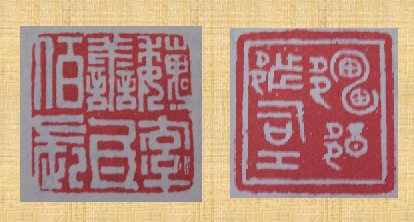
Private
seals
Private
seals were not regulated by the governments and therefore they had the
largest variety in content, shape, size, material and calligraphy styles. Despite of
their varied characteristics, they can still be categorized based on their uses.
Seals
with names, pen names, pseudonyms, and etc on them were used as a signature by
people in their private life. This is how artists signed their works and letters.
Chinese literati commonly used a number of different pen names. So identifying
an artist's name from a seal can be a profound skill.
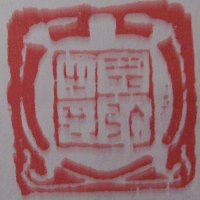
Collector's
Seals ( 收藏章
) were mainly used for the purpose of authenticating pieces of art. Thus a
seal of a famous collector or connoisseur would become an integral part of a
work of art and could substantially raise its value. Thus in the course of
several centuries, some Chinese paintings became covered by a dozen of different
seals.
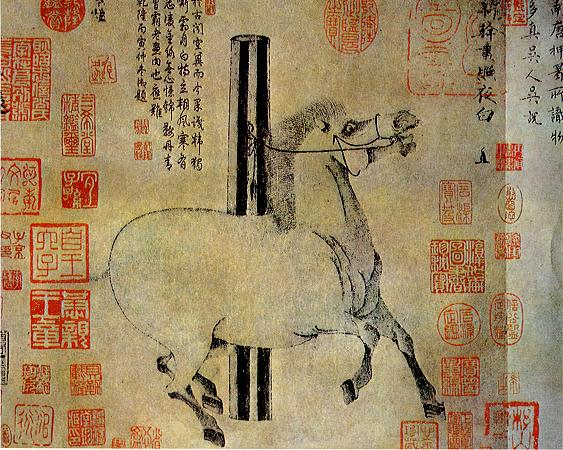
The
rest of private seals can be conveniently categorized as "Leisure Seals 閑章". The inscription on these seals is usually a short
phrase quoted from a poem or saying that the seal owner thought was poetic or
meaningful.
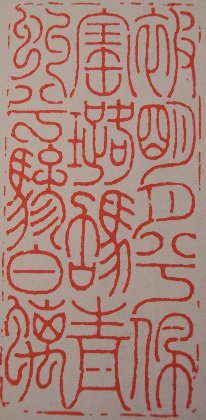
A
master seal engraver must be able to write different styles of the Chinese
scripts and arrange all the characters in a perfect balance. Sometimes the
artist has to exaggerate the thickness or thinness of a stroke, elaborately
straighten or curve it, or even deliberately deform an ideogram to create an
artistic effect. Basically, a master seal engraver must also be a great Zuan Shu
calligrapher.
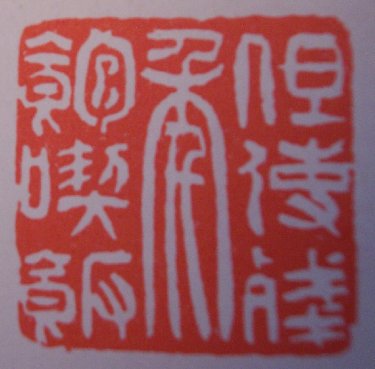
The
strokes of the Zuan Shu character in the middle were deliberately lengthened
A
perfect seal also relies heavily on the engraver's speed and strength of his
wrist and finger movements as well as the particular tools used. The engraver
should also be very familiar with different materials like jade, gold, brass,
and stone, so that he can apply the tool with the right strength and rhythm.
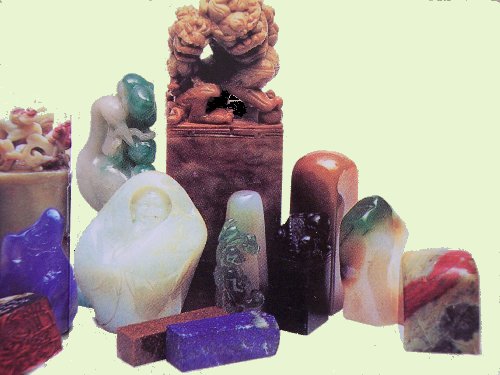
Seal
carving is an integration of limitation and infinity. A seal's physical size and
space are totally unproportionate to its spiritual content in a condensed art
form. The meaning it intends to
express is often extremely delicate and abstruse. Under the carving knives of
outstanding seal engravers, dots, lines, raises, concaves, sparsity, density,
punching, and cutting have all become demonstrative elements in highly abstract
forms.
A good seal stamp on a Chinese calligraphy or painting work will give the artwork a new look. A good Chinese painter or seal maker must be a good Chinese calligrapher because Chinese painting and seal making both have a strong root in Chinese calligraphy. However, a good Chinese calligrapher does not necessarily need to be a painter or seal maker. Nowadays people seem to neglect the strict rules of putting seal stamps on calligraphy and painting works in appropriate positions due to lack of study.
Recommended
reading in English: http://www.kk-ma.com/ma/home_books.htm